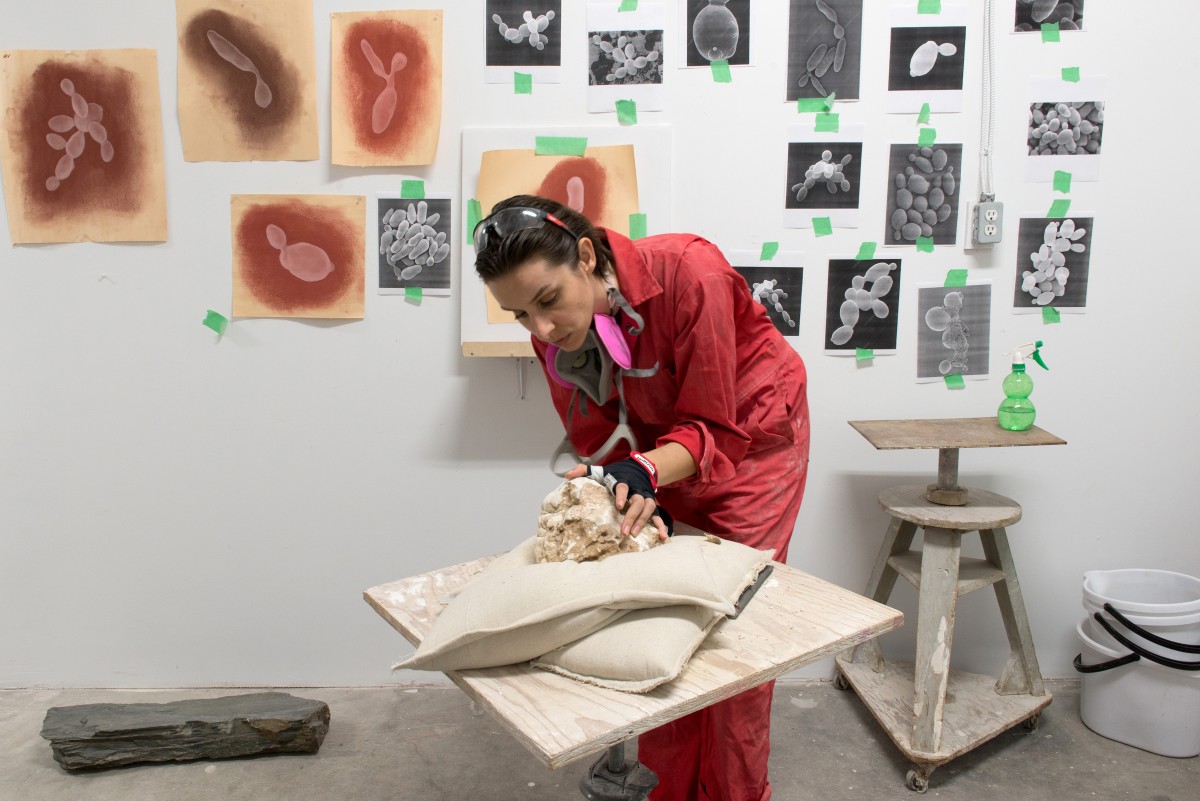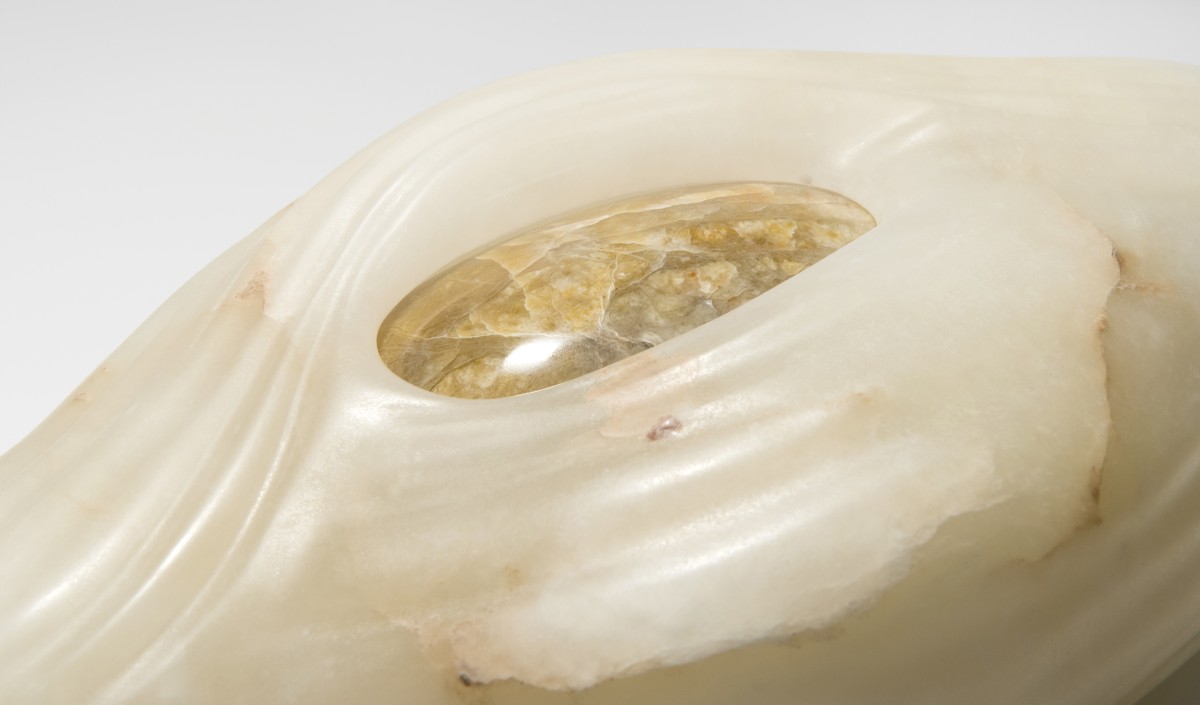Sculpture from a microscope
Toronto artist Jennifer Rose Sciarrino takes us on a behind-the-scenes tour of her studio, creative process and inspirations.

Jennifer Rose Sciarrino, butterfly buffet, Daniel Faria Gallery, Toronto 2020. Courtesy of the artist and Daniel Faria Gallery. Photographed by LF documentation.
Carved out of alabaster and polished by hand, Toronto-based artist Jennifer Rose Sciarrino’s sculptural work bufferfly buffet (2020) is a recent addition to the AGO Collection. Inspired by microbiology, its many elements come together to form a whole. Sitting at the intersection of science, nature and technology, Sciarrino’s works are rooted in the human condition and our relationship with the living world.
Curious to learn how she works with intricate media and the steps behind her creative process, we caught up with Sciarrino to find out more. Here’s what she had to say.
AGOinsider: Tell us about your inspiration for your artwork butterfly buffet (2020)?
Sciarrino: The sculpture butterfly buffet is part of a series of carved alabaster pieces exhibited at Daniel Faria Gallery in fall 2020 in my solo exhibition for Swan. In this ongoing series, each piece is an abstracted depiction of microscopic elements, organisms and biota (e.g. plants, fungi, bacteria, animals) in the process of becoming symbionts. These pieces are intended to be like they are interacting with each other or that they are caught in the act of spooning, growing, holding, spewing, sprouting, cuddling or entangling in an entwining relationship. It is unclear if they have chosen this collaboration or if it was imposed on them. Did they need each other to thrive in a changing ecosystem or select each other in a desire to become something else?
butterfly buffet is composed of several components. The first is a kind of “plate” with the likeness to a milkweed seed. It holds and spills smaller elements that resemble seeds of other plants preferred by butterflies; lupine, aster and wild bergamot. Each type of seed is sculpted from a different colour of alabaster; brown, black, pink and white. If these plants were to go extinct, their pollinators would diminish. This piece is imagining them coming together, joining or even simply protecting each other.
AGOinsider: Working with glass and rock is incredibly difficult – why do you choose them?
Sciarrino: Sometimes I wonder if I've been seduced by them. I like both materials because they are simultaneously strong and delicate and that feeling resonates heavily into the forms they become. Because I'm working with aspects of nature, I am partial to how elemental these materials are. They also communicate together well, maybe because they are both composed of sand and earth. With stone, part of the process is accentuating an elemental beauty within it. It is deeply rewarding work. They are incredibly generous materials.
I don't blow or cast the glass myself. I have that done by fabricators with the means and training to do so. But I have been lucky to observe the process and work with fabricators who really understand the ideas and feelings I want the pieces to have and help me achieve that.
I carve stone using tools like chisels, grinders and files. Each piece presents a new challenge. It is very physical, hard and dusty work – but so worth it. The finishing stage involves sanding the pieces with 10 steps of abrasives and polish, lots of repetitive work, but each step reveals more beauty from the rock and becomes addictive. The material pulls me in, keeps me on my toes, is open to taking form but also teaches me how to work with it. It's a great collaborative relationship.
AGOinsider: What does your studio space look like and how does that space impact your practice?
Sciarrino: My studio space looks like a piece of pie, it is a pie shape. One part of it is for cleaner working and the other is for messy working. It isn't large, so I can't make anything immense, but it's big enough for the work I'm doing at the moment. I have access to a garage door and can work outside when I'm doing really dirty work. The majority of the process of carving stone is exceptionally dusty and having the ability to work outside is essential. In the colder months, I was drawing a lot and planning with maquettes or chiseling stones. My studio doesn't have any windows so this winter I installed some grow lights and some hearty plants to let a little nature in. My current studio is in a building full of artists, creatives, makers, etc. I am very close to an amazing fabricator that I work with a lot and that feels very lucky.
AGOinsider: Tell us a little about your creative process. How many stages are there from idea to finished object?
Sciarrino: The ideas take the longest amount of time. I usually have a pretty refined idea before I begin a piece or an exhibition. I will often do 3-D modeling on the computer to plan a sculpture and almost always use this tool for planning an exhibition. Most of the pieces I make are intended for something specific, so there is a lot of planning involved in how a sculpture, video or installation will behave and perform in the space.
For my more recent work, I spend a lot of time collecting microscopic images for reference. The process of learning and collecting them influences the combinations of organisms that I play with. A kind of fiction emerges: what could happen if these biotas began to entangle? What and why are they becoming?
Choosing materials, type and colour of glass, and shape and colour of stones is a significant stage. Afterward, it's all sculpting and carving with a lot of learning and experimentation, coupled with patience and practice. I'm getting a lot better at reading stones, stone carving techniques, etc. I started carving in 2018, so it's not been long, but I'm learning how to feel my way through the process. When I'm trying to form stones in, around and on each other, there is a very slow process of carving them little by little until they nestle into each other. It ends with polishing and buffing.
AGOinsider: Any upcoming future projects you're working on?
Sciarrino: I am working on two upcoming projects. One is a new installation of carved stone for Greater Toronto Art 2021 at MOCA. I'm carving stone from Canada, mostly Ontario, which is a very different experience. There is a familiarity to it, but it is also unlike any stone I have carved before. Some of the stones are grainier, harder, crystallized or fragmented and in some ways very unpredictable. It is a really exciting challenge. The second project is a solo booth in the Focus section of Armory with Daniel Faria Gallery.
Also, I think I would like to start writing short science fiction; it's time to try.
Check out Sciarrino’s conversation with AGO Curator Adelina Vlas from the AGO’s Art in the Spotlight series, in which she gives a deeper dive into her work and inspiration. Sign up as an AGOinsider to be the first to know about artist talks, upcoming exhibitions and exciting programming at the AGO.


